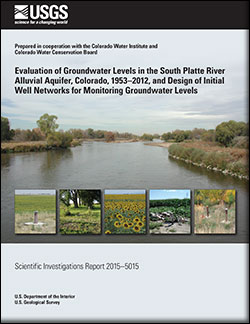 Abstract
Abstract
The South Platte River and underlying alluvial aquifer form an important hydrologic resource in northeastern Colorado that provides water to population centers along the Front Range and to agricultural communities across the rural plains. Water is regulated based on seniority of water rights and delivered using a network of administration structures that includes ditches, reservoirs, wells, impacted river sections, and engineered recharge areas. A recent addendum to Colorado water law enacted during 2002–2003 curtailed pumping from thousands of wells that lacked authorized augmentation plans. The restrictions in pumping were hypothesized to increase water storage in the aquifer, causing groundwater to rise near the land surface at some locations. The U.S. Geological Survey (USGS), in cooperation with the Colorado Water Conservation Board and the Colorado Water Institute, completed an assessment of 60 years (yr) of historical groundwater-level records collected from 1953 to 2012 from 1,669 wells. Relations of “high” groundwater levels, defined as depth to water from 0 to 10 feet (ft) below land surface, were compared to precipitation, river discharge, and 36 geographic and administrative attributes to identify natural and human controls in areas with shallow groundwater.
Averaged per decade and over the entire aquifer, depths to groundwater varied between 24 and 32 ft over the 60-yr record. The shallowest average depth to water was identified during 1983–1992, which also recorded the highest levels of decadal precipitation. Average depth to water was greatest (32 ft) during 1953–1962 and intermediate (30 ft) in the recent decade (2003–2012) following curtailment of pumping. Between the decades 1993–2002 and 2003–2012, groundwater levels declined about 2 ft across the aquifer. In comparison, in areas where groundwater levels were within 20 ft of the land surface, observed groundwater levels rose about 0.6 ft, on average, during the same period, which demonstrated preferential rise in areas with shallow groundwater.
Approximately 29 percent of water-level observations were identified as high groundwater in the South Platte River alluvial aquifer over the 60-yr record. High groundwater levels were found in 17 to 33 percent of wells examined by decade, with the largest percentages occurring over three decades from 1963 to 1992. The recent decade (2003–2012) exhibited an intermediate percentage (25 percent) of wells with high groundwater levels but also had the highest percentage (30 percent) of high groundwater observations, although results by observations were similar (26–29 percent) over three decades prior, from 1963 to 1992. Major sections of the aquifer from north of Sterling to Julesburg and areas near Greeley, La Salle, and Gilcrest were identified with the highest frequencies of high groundwater levels.
Changes in groundwater levels were evaluated using Kendal line and least trimmed squares regression methods using a significance level of 0.01 and statistical power of 0.8. During 2003–2012, following curtailment of pumping, 88 percent of wells and 81 percent of subwatershed areas with significant trends in groundwater levels exhibited rising water levels. Over the complete 60-yr record, however, 66 percent of wells and 57 percent of subwatersheds with significant groundwater-level trends still showed declining water levels; rates of groundwater-level change were typically less than 0.125 ft/yr in areas near the South Platte River, with greater declines along the southern tributaries. In agreement, 58 percent of subwatersheds evaluated between 1963–1972 and 2003–2012 showed net declines in average decadal groundwater levels. More areas had groundwater decline in upgradient sections to the west and rise in downgradient sections to the east, implying a redistribution of water has occurred in some areas of the aquifer.
Precipitation was identified as having the strongest statistically significant correlations to river discharge over annual and decadal periods (Pearson correlation coefficients of 0.5 and 0.8, respectively, and statistical significance defined by p-values less than 0.05). Correlation coefficients between river discharge and frequency of high groundwater levels were statistically significant at 0.4 annually and 0.6 over decadal periods, indicating that periods of high river flow were often coincident with high groundwater conditions. Over seasonal periods in five of the six decades examined, peak high groundwater levels occurred after spring runoff from July to September when administrative structures were most active. Between 1993–2002 and 2003–2012, groundwater levels rose while river discharge decreased, in part from greater reliance on surface water and curtailed pumping from wells without augmentation plans.
Geographic attributes of elevation and proximity to streams and rivers showed moderate correlations to high groundwater levels in wells used for observing groundwater levels (correlation coefficients of 0.3 to 0.4). Local depressions and regional lows within the aquifer were identified as areas of potential shallow groundwater. Wells close to the river regularly indicated high groundwater levels, while those within depleted tributaries tended to have low frequencies of high groundwater levels. Some attributes of administrative structures were spatially correlated to high groundwater levels at moderate to high magnitudes (correlation coefficients of 0.3 to 0.7). The number of affected river reaches or recharge areas that surround a well where groundwater levels were observed and its distance from the nearest well field showed the strongest controls on high groundwater levels. Influences of administrative structures on groundwater levels were in some cases local over a mile or less but could extend to several miles, often manifesting as diffuse effects from multiple surrounding structures.
A network of candidate monitoring wells was proposed to initiate a regional monitoring program. Consistent monitoring and analysis of groundwater levels will be needed for informed decisions to optimize beneficial use of water and to limit high groundwater levels in susceptible areas. Finalization of the network will require future field reconnaissance to assess local site conditions and discussions with State authorities.